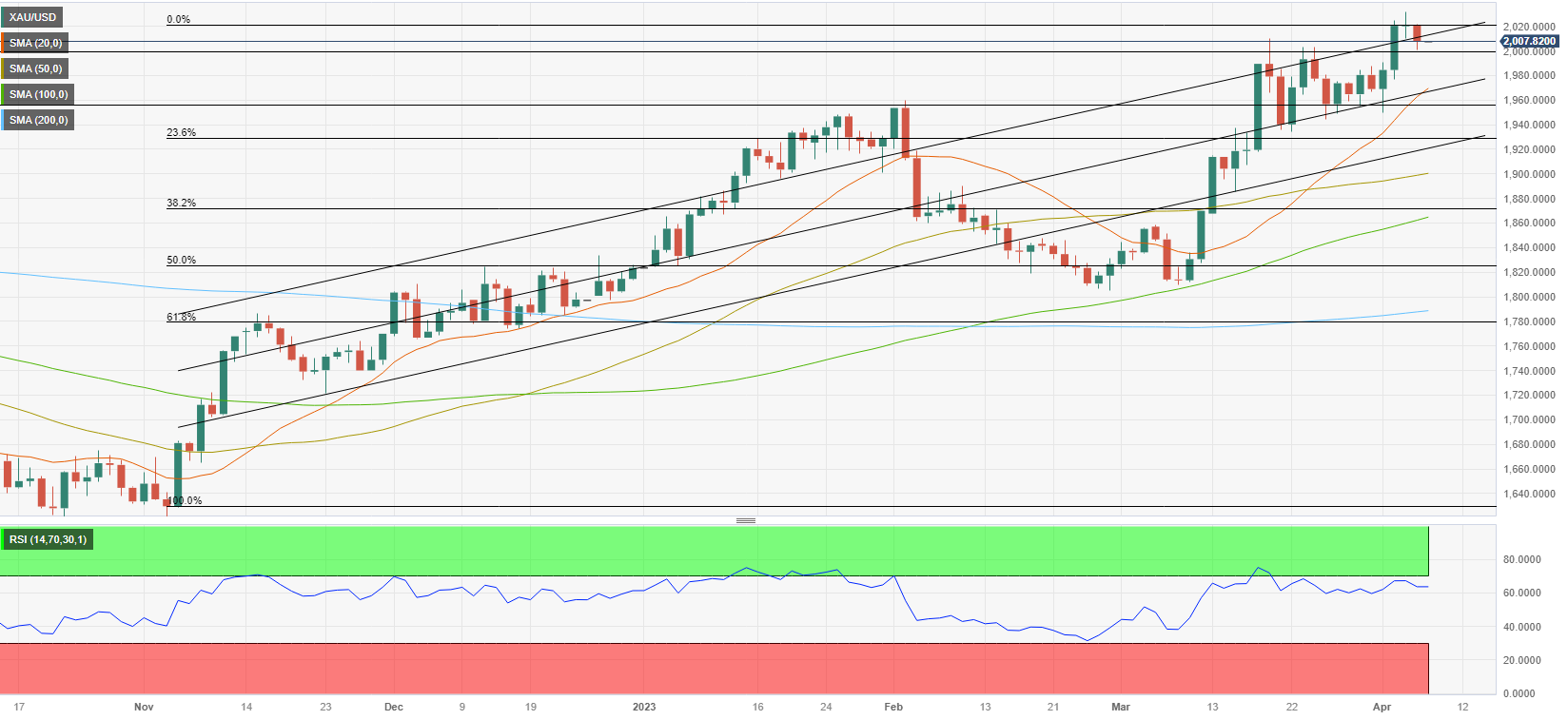- Gold price registered a weekly close above $2,000 for the first time ever.
- March inflation data from the US could provide a directional clue to XAU/USD.
- The bullish bias stays intact in the near term technical outlook.
Gold has gained traction to start the week and extended its rally after clearing $2,000. Although XAU/USD retreated in the second half of the week from the one-year high it touched above $2,030, it managed to snap a two-week losing streak and posted its first weekly close above $2,000. Next week, March inflation data from the US and trade balance figures from China could impact the precious metal’s valuation.
What happened last week?
The US Dollar (USD) came under selling pressure in the American session after the monthly PMI report published by the ISM revealed that the economic activity in the manufacturing sector continued to contract at an accelerating pace in March. Additionally, the inflation component of the survey, the Prices Paid sub-index, and the Employment sub-index both came in below 50, showing a decline in the sector’s input inflation employment. XAU/USD capitalized on the USD weakness and registered daily gains.
On Tuesday, Gold price gathered bullish momentum and surpassed $2,000. Technical buyers showed interest following this move and XAU/USD rose nearly 2% on a daily basis. The sharp decline seen in the benchmark 10-year US Treasury bond yield fueled the pair’s rally. The US Bureau of Labor Statistics (BLS) reported that the number of job openings on the last business day of February stood at 9.9 million, compared to 10.5 million in January, and caused investors to lean toward the US Federal Reserve (Fed) leaving its policy rate unchanged in May.
Although Gold price reached its highest level since March 2022 at $2,032 early Wednesday, it struggled to preserve its bullish momentum and closed the day flat. Despite the disappointing ISM Services PMI report, which highlighted a loss of momentum in the service sector’s business growth, the USD found a foothold amid risk aversion. Disappointing data releases revived fears over the US economy tipping into recession and limited XAU/USD’s upside.
Gold price staged a technical correction on Thursday as the 10-year US Treasury bond yield recovered above 3.3% from the multi-month low it set at 3.25% earlier in the week. The US Department of Labor (DOL) announced that there were 228,000 initial jobless claims in the week ending April 1, compared to the market expectation of 200,000. The DOL, however, noted that they have revised seasonal adjustment factors and markets refrained from reacting to this data.
On Friday, the BLS reported that Nonfarm Payrolls (NFP) rose by 236,000 in March and the Unemployment Rate declined to 3.5% on the back of an increase to 62.6% in Labor Force Participation rate. Furthermore, wage inflation, as measured by Average Hourly Earnings, declined to 4.2% on a yearly basis from 4.6% in February. With the initial reaction to this data, the 10-year US yield gained more than 1% in the shortened session.
Next week
Many major global and stock markets will remain closed on Easter Monday and XAU/USD is likely to stay quiet at the beginning of the week.
Late Monday or early Tuesday, a delayed reaction to the US March jobs report could be witnessed with trading volumes returning to normal levels. Improving Labor Force Participation Rate, falling wage inflation and the loss of momentum in NFP growth, which all point to softening conditions in the labor market, could translate into lower US yields and allow Gold price to gain traction. However, it’s worth remembering the uptick in yields on Friday. Markets could still see that report as “good enough” to constitute one more Fed rate increase in May. In that case, an extended rebound in yields should cap XAU/USD’s upside.
The US BLS will release the Consumer Price Index (CPI) data for March on Wednesday. The Core CPI, which excludes volatile energy and food prices, remained steady at 5.5% in February with a monthly increase of 0.5%. In March it is expected to rise by 5.6% and 0.4% respectively. In case the monthly Core inflation reading comes in softer than expected, at 0.3% or lower, markets could reconsider to price in a no-change in the Fed policy rate in May which would weigh on US T-bond yields, allowing XAU/USD to gather bullish momentum. On the other hand, a hot monthly core inflation, at 0.7% or higher, is likely to cause investors to continue to bet on a 25 bps hike and have the opposite effect on the pair’s action.
In the Asian trading hours on Thursday, Trade Balance data from China will be watched closely by market participants. Markets forecast the trade surplus to decline to $91.72 billion in March from $116.8 billion in February. Earlier this week, International Monetary Fund (IMF) Managing Director Kristalina Georgieva said they project the global economy to grow by less than 3% in 2023, down from 3.4% in 2022. A disappointing trade report from China could revive concerns over a global economic slowdown and weigh on Gold price and vice versa.
Finally, March Retail Sales and the University of Michigan’s Consumer Sentiment Index for April will be featured in the US economic docket on Friday. A sharp decline in Retail Sales could hurt the USD and help XAU/USD end the week on a firm footing but it would be surprising to see the data having a long-lasting impact on the USD’s valuation.
Gold price technical outlook
XAU/USD’s pullback on Wednesday and Thursday looks to be a technical correction following the pair’s climb outside of the ascending regression channel coming from November. The Relative Strength Index (RSI) indicator on the daily chart holds near 60, suggesting that the bullish bias stays intact in the near term.
In case the pair extends its correction, $2,000 (psychological level, static level) aligns as initial support. With a daily close below that level, additional losses toward $1,980 (20-day Simple Moving Average (SMA), mid-point of the ascending channel) and $1,960 (static level) could be witnessed.
If $2,000 stays intact, Gold price could stay in a consolidation phase early next week before targeting $2,020 (static level), $2,032 (one-year high set on April 5) and finally $2,050 (static level from March 2022).
Information on these pages contains forward-looking statements that involve risks and uncertainties. Markets and instruments profiled on this page are for informational purposes only and should not in any way come across as a recommendation to buy or sell in these assets. You should do your own thorough research before making any investment decisions. FXStreet does not in any way guarantee that this information is free from mistakes, errors, or material misstatements. It also does not guarantee that this information is of a timely nature. Investing in Open Markets involves a great deal of risk, including the loss of all or a portion of your investment, as well as emotional distress. All risks, losses and costs associated with investing, including total loss of principal, are your responsibility. The views and opinions expressed in this article are those of the authors and do not necessarily reflect the official policy or position of FXStreet nor its advertisers. The author will not be held responsible for information that is found at the end of links posted on this page.
If not otherwise explicitly mentioned in the body of the article, at the time of writing, the author has no position in any stock mentioned in this article and no business relationship with any company mentioned. The author has not received compensation for writing this article, other than from FXStreet.
FXStreet and the author do not provide personalized recommendations. The author makes no representations as to the accuracy, completeness, or suitability of this information. FXStreet and the author will not be liable for any errors, omissions or any losses, injuries or damages arising from this information and its display or use. Errors and omissions excepted.
The author and FXStreet are not registered investment advisors and nothing in this article is intended to be investment advice.
Recommended Content
Editors’ Picks

ECB reduces rates by 25 bps as largely expected – LIVE
On Thursday, the ECB delivered the 25 bps cut everyone expected, trimming the Deposit Facility Rate to 2.25%. EUR/USD remained within its daily sideline theme around the 1.1350-1.1360 band in the wake of the release. Now, all eyes are on Christine Lagarde’s live press conference as investors hang on her every word for clues about what comes next.

GBP/USD trades in an inconclusive fashion around 1.3230
GBP/USD is stuck in the 1.3250–1.3260 corridor on Thursday, maintaining a rangebound mood in response to the acceptable bounce in the Greenback and the generalised offered bias in the broad risk-linked galaxy.

Gold remains affered, recedes to the $3,340 area post-ECB
Gold powered to a fresh record, flirting with the $3,360 area per troy ounce, before embarking on a correction to the current $3,340 zone, always on the back of the decent rebound in the US Dollar and the recovery in US Treasury yields across the curve.

Crypto market cap fell more than 18% in Q1, wiping out $633.5 billion after Trump’s inauguration top
CoinGecko’s Q1 Crypto Industry Report highlights that the total crypto market capitalization fell by 18.6% in the first quarter, wiping out $633.5 billion after topping on January 18, just a couple of days ahead of US President Donald Trump’s inauguration.

Future-proofing portfolios: A playbook for tariff and recession risks
It does seem like we will be talking tariffs for a while. And if tariffs stay — in some shape or form — even after negotiations, we’ll likely be talking about recession too. Higher input costs, persistent inflation, and tighter monetary policy are already weighing on global growth.

The Best brokers to trade EUR/USD
SPONSORED Discover the top brokers for trading EUR/USD in 2025. Our list features brokers with competitive spreads, fast execution, and powerful platforms. Whether you're a beginner or an expert, find the right partner to navigate the dynamic Forex market.

